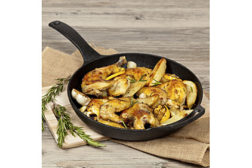Home » formulation of meat and poultry products
Articles Tagged with ''formulation of meat and poultry products''
Special Report
Health-conscious consumers still see benefits to keeping animal protein in their diet, but not if the portion sizes don’t fit their ideals.
Read More
Chiming in on culinary trends
Christopher Hansen, corporate executive chef, OSI Group, offers his thoughts on burgers, clean label and sodium reduction.
Read More
Guest Commentary
The big 3 for R&D
Three areas on which meat-processing R&D teams should focus.
Read More
Formulation Strategies
Lunch Formulation Trends: 'Standard' out to lunch
As operators trim lunch menus, commodity offerings are losing out to options perceived healthier, more convenient, more sustainable and more unique in their flavor profiles.
Read More
In search of the right spice
Spices and seasonings can make meats safer and more nutritious, but incorporating ingredients that won’t compromise the sensory appeal of proteins remains a stumbling block.
Read More
Formulation Strategies
Protein's new role in snacks, appetizers and side dishes
Rising meat prices and changes in consumer eating patterns result in greater use of proteins beyond the traditional center of the plate.
Read More
Meat Science Review
Investigating the use of PLA2 in ground proteins
The effect of phospholipase A2 from pig pancreas on lipid oxidation in minced muscles from fish, poultry and pork.
Read More
Higher Education
Mizzou offers pathway to jobs in animal, food science industries
August 11, 2014
Formulation Strategies
Dinner Trends: From roasts to recipes
Meat and seafood are moving away from their traditional place as center-of-the-plate featured offerings as shoppers seek meals that are more creative, cost-effective and quicker to prepare.
Read More
Stay ahead of the curve. Unlock a dose of cutting-edge insights.
Receive our premium content directly to your inbox.
SIGN-UP TODAYCopyright ©2024. All Rights Reserved BNP Media.
Design, CMS, Hosting & Web Development :: ePublishing














